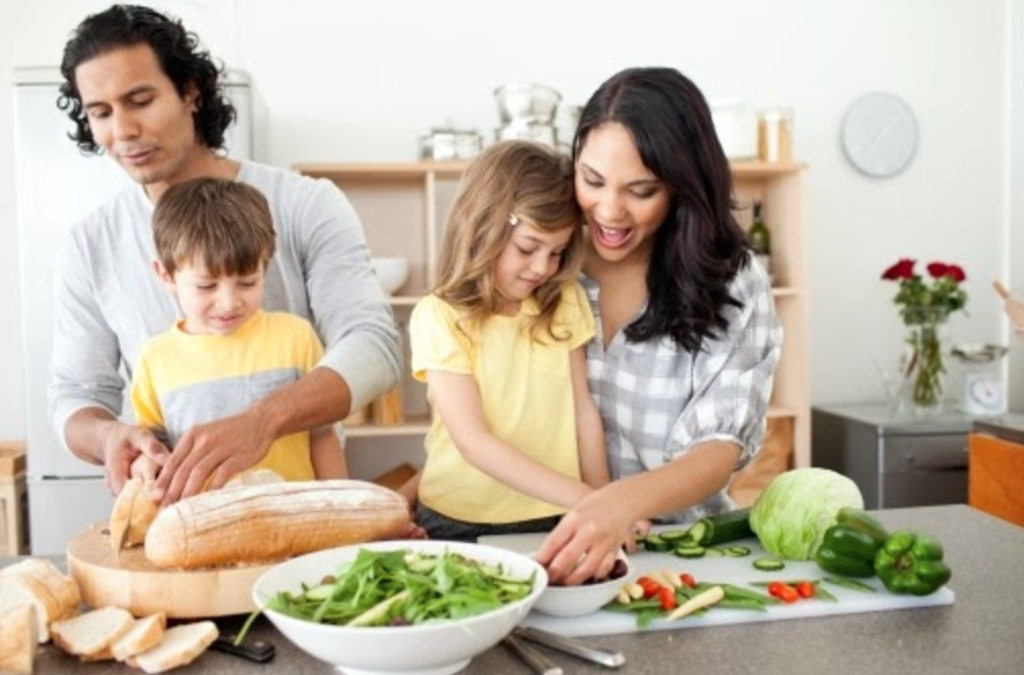

The joy of cooking is for kids too
The Catholic Kids’ Cookbook: Holy Days and Heavenly Food by Haley Stewart and Clare Sheaf. Word on Fire, 2024. 208 pp., $34.95
As Thanksgiving and Christmas draw near, they offer ample opportunity for parents to experience the joys and frustrations of baking and cooking with kids. In my kitchen, counter space is limited, so when little chefs are helping, I have to get creative about space—while keeping a close eye out for disaster. There is a certain amount of stress built into anything involving heat, knives, and children.
Still, teaching children to cook is a worthwhile part of holiday traditions. Over time, it pays dividends beyond the experience of quality time together. If you put in the effort to teach kids kitchen skills while they are young, one day you will suddenly find that your children can do things like mix, bake, and frost cut-out sugar cookies without any help from you at all—and might even be willing to let their younger siblings help. You, meanwhile, will be sitting in another room with your feet up. Having competent child cooks and bakers in the house is a boon for all concerned.
There is one downside, however. Since kid chefs tend to choose sweet recipes, their flourishing independence in the kitchen is not always great for their parents’ waistlines. Partly in response to this tendency, our family has found it helpful to tie treats to the rhythms of the Christian year rather than eating massive batches of kid-made sugar cookies willy-nilly across the seasons. Although a spontaneous trip to the ice cream shop remains a part of life, we try to emphasize treats as elements of celebration rather than part of our daily routine. We link special foods to feast days when we can. Every week there is a “Sunday treat” of some sort, and likewise on holy days. The Christian cycles of feasting (cookies!) and fasting (potato-leek soup!) are designed in their wisdom to help us along. Why not teach kids to embrace this philosophy in the kitchen?
Haley Stewart and Clare Sheaf’s new cookbook combines these two goals: to teach kids to cook, and to teach them moderation and celebration by connecting special foods to holy times of year. It is a cookbook that older kids can use independently. Its recipes, both sweet and savory, are tied to Christian feasts and fasts. And although the book is Catholic in tone, many families from other high church Christian traditions will appreciate its ideas. Finally, it is a beautiful book, visually speaking: Sheaf’s photography of the dishes is stunning, and the recipes are paired with Christian art from across the ages. It is the sort of book that visitors like to pick up from the shelf and page through.
This is a great resource to hand to your child as a special day or season approaches, and ask: What would you like to make? I myself did this three times over the course of reviewing the book. Rather than testing the recipes myself, it seemed best to ask my kids to use the book in the way it’s intended: my ten-year-old without much input from me at all, and my seven- and four-year-olds with me as sous-chef. Each child thus chose, prepared, and cooked or baked one recipe. (My thirteen-year-old, though very interested in the book, was too busy with schoolwork to try out a recipe in time for this review.) Although there are many savory recipes, including soups, breads, and even sushi, I was not at all surprised that my children chose sweet recipes. The results did not disappoint.
My fifth-grade son chose to make Lemon Possets (Eyes of St. Lucy). If you haven’t had these before, they are simple yet impressive—lemon puddings served in scooped-out lemon rinds. This recipe requires some patience and a little bit of prior cooking knowledge (e.g., to help determine how often to stir the heating liquids). But there are worse things to learn on a Saturday morning than stirring norms and patience, especially when the lesson results in a lemony treat. The flavor of the puddings was delicious, and the lemon-rind presentation was very well-received.
My second son, aged seven, chose the St. John the Baptist’s Wild Honey Cake, which contained plenty of honey but, I am happy to say, not a single locust. At first, my son was not enthused, as I had called him away from fort-building in order to bake. Once he realized he would get to crack some eggs, however, he was on board. He was able to read and understand the instructions well even at his second-grade reading level, and only needed minimal help with measuring the ingredients and putting them together. We cut up some berries, dolloped the finished cake with whipped cream, and shared it with the neighbor kids. It was promptly devoured.
Finally, my youngest daughter chose a moderately complex recipe: Le Colombier Dove Cake, a traditional French cake served at Pentecost. I was an active sous-chef in this instance, as she is only four years old. But she looked forward to our baking date for a solid two weeks and enjoyed getting to be in charge. She was perfectly capable of doing every part of the recipe except reading the words and operating the oven. More than once, she reminded me that she was the cook, whereas I was just the helper. The cake turned out well and looked stunning on the plate. At family prayers that night, two separate kids thanked God aloud for “that cake.” It really was delicious.
These three recipes represent three different cooking skill sets and are representative of the book’s variety and versatility. To be honest, I don’t know that I’ve ever used a kids’ cookbook before that has worked so well for each of my children at their different ages. Usually the recipes are either too simple for the older kids or too complex for the younger ones. This book, by contrast, seems to have been created with families with multiple children in mind, which means it is likely to stick around for quite some time and get considerable use.
One more note about this book and my seven-year-old. This boy has not been very enthusiastic about cooking in the past. Having the experience of independently reading a recipe that was clear and accessible to him at his reading level, and then getting to take the lead on making it, gave him greater confidence. Indeed, soon after making the honey cake, he initiated another big baking project without any prompting at all: He made a batch of chocolate chip cookies, packaged them up, and went door to door selling them to neighbors. (He made a killing.) I’m grateful to Stewart and Sheaf for providing recipes that have piqued this interest!
Perhaps this book will pique the interest of the children you love as well. And then maybe someday, you’ll have the chance to put your feet up while someone else makes dinner.
Dixie Dillon Lane is an American historian, an associate editor at Hearth & Field, and a contributing editor at Front Porch Republic. Her book, Skipping School: Finding the Roots of Modern Homeschooling in the American Past, is under contract with Eerdmans. Dixie maintains a newsletter of her writing at TheHollow.substack.com.